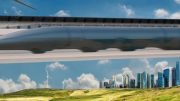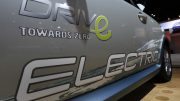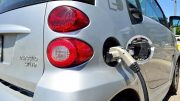 It was never meant to happen like this, and by and large it doesn’t. Electric cars were hailed as a new dawn of clean, environment-friendly, safe driving.
It was never meant to happen like this, and by and large it doesn’t. Electric cars were hailed as a new dawn of clean, environment-friendly, safe driving.
And then someone lost their life behind the wheel of such a car. Joshua Brown, aged 40, died in the first known fatal crash involving a car in self-driving mode. Joshua’s Tesla Model S struck the trailer of a lorry on a road in May. According to the highway patrol in Florida the car’s windscreen hit the bottom of the trailer. His car’s autopilot mode failed to recognise the oncoming truck. National highways chiefs are investigating that autopilot system – one used in 25,000 Model S cars. A Tesla statement on the sensors, which help steer the car by identifying obstructions, said they failed to recognise the oncoming vehicle: “Neither autopilot nor the driver noticed the white side of the tractor trailer against a brightly lit sky, so the brake was not applied.”
Tragedy apart, electric cars have a track record that is good, argue not only their makers but a growing section of environment and road-safety lobbies. One blogpost on the Tesla tragedy in the UK’s Independent newspaper read: “That’s pretty good going, statistic wise. How many people have died in manually driven cars since the Tesla first drove on the road? A few more than one!”
Electric cars were – and still are – being hailed as a new dawn. President Barack Obama predicted one million electric cars in the US by 2015 while Virgin boss Richard Branson forecast last summer no new road cars would be petrol driven within 20 years. Combustion engines, insisted the British tycoon, were “complicated and antiquated”.
Any doubts electric cars are the future evaporate as soon as you set eyes on the sleek lines of the newest models and then hit the on-switch. Today’s high-end electric car is little short of a supercar, and everyone is in on the act, trialling, prototyping or bringing to market their own versions. BMW, Mercedes and Audi have all unveiled visions of the automotive future at car shows or in glossy aspirational magazines. Most of them boast – or promise – rapid acceleration thanks to a smooth, seamless supply of power from their electric motors.
What sets that motor apart from dirty gas guzzlers is the instant, massive twisting force it produces, called torque. This does away with the need for a gearbox and is more efficient at turning stored energy into motion. It saves weight and clears space for all those boys’ toys like touch-screen controls. But the environmental savings are as alluring as the savings in running costs, not just to drivers but governments, municipal authorities and the medical profession. By switching to electric vehicles, average household greenhouse-gas emissions are cut by over a whopping 40%, according to some experts. And as transport is said to contribute 23% of global greenhouse gas emissions, much hinges on the future development of the electric car in tackling climate change.
No wonder all the giant carmakers in America, China and Japan have spent billions of dollars to bring electric vehicles to the market. Yet it was General Motors that rolled out the first mass-produced, purpose-designed electric vehicle of the modern era, the EV1, from 1996 to 1999. And then they tried to kill it.
A 2006 documentary, Who Killed the Electric Car?, explored the creation, limited commercialisation and attempts to destroy the electric car phenomenon by traditional car makers, the oil industry, US government and others by trying to stymie development and adoption of this revolutionary but hugely controversial technology. It was a gutsy Silicon Valley start-up, Tesla, founded by the PayPal tycoon Elon Musk that pioneered a market-leading car of the same name using improved versions of industry-standard lithium-ion batteries.
Pros and cons include faster acceleration but a shorter distance range than conventional engines. There is no exhaust but there are long charging times. And the technology roars on. Formula E, the electric equivalent of Formula 1, is gaining traction with sports fans, and next up are driverless cars.
The Google self-driving car forms part of a new breed of ‘autonomous cars’, from the so-called Google X project to develop technology for mainly electric cars. The implication is huge. Near-perfect robotic drivers using ultra-precise digitised map technology could cut traffic accidents – maybe even the kind that killed Joshua Brown – and trim travel times as well as save on carbon emissions.
Driving an electric car is seen as a high-tech, pacey green badge of honour. Or is it? Electric cars have higher manufacturing emissions than normal cars, argue some. Electric cars also use electricity that has its own footprint, insist others. Put them together and they wipe out any climate benefit of electric cars. Academics from University of Minnesota meanwhile claimed in report published in 2014 that a battery-powered car recharged with electricity generated by coal-fired power stations was likely to cause more than three times as many deaths from pollution as a conventional petrol-driven vehicle. And sales, though promising, have hardly taken off: President Obama’s prediction of one million electric cars in the US by 2015 fell somewhat short: 280,000.
The Renault-Nissan alliance, meanwhile, is cagey on sales targets. A 2011 prediction of 1.5m electric vehicles by 2016 turned out to be wildly optimistic. The group passed the 250,000 mark only last July. And yet the electric car is enjoying seemingly unstoppable, if not super-fast, momentum, thanks in part to the magical blend of offering motorists the chance to save money and reduce toxic exhaust emissions. Sales of cars such as the Nissan Leaf, Ford Focus Electric, the Tesla Model S and Chevrolet Volt may not be breaking records but they are indisputably on the up. As of the start of this year there were more than 30 models of all-electric cars and utility vans on sale in Western Europe, the United States, China and Japan. Popularity is also due in part to subsidies. Germany announced in April it would to give a €1bn subsidy to boost electric car sales: buyers receive €4,000 when they choose a purely electric vehicle and €3,000 for a plug-in hybrid. And a ‘plug-in vehicle grant’ from the UK government provides a subsidy of up to 35% of the cost of a car or van, up to a maximum of €5.360 (£4,500). All this gives an insight into the technological, corporate and political forces coming together to deliver vehicles that one day really will change the world, be it electric or driverless cars. Better batteries will give electric and hybrid cars even stronger performance and increased range, which will further improve their appeal, promise manufacturers. But the batteries also need to be cheaper for the mass market.
This throws up another intriguing twist involving the fall in oil prices. Lower fuel costs combined with the unprecedented efficiency of today’s petrol engines, suddenly makes old technology a worthy rival to electric cars and batteries. What the latter have is is a tantalising, ever-evolving technology.
Back in March at the Geneva Motor Show 2016, architecture firm Foster + Partners and Nissan unveiled a vision for self-charging driverless cars that could power the home. Technologies included wireless charging, autonomous driving and battery storage to present a compelling proposal for the future of vehicles and cities.
Carlos Ghosn, the head of the Renault-Nissan alliance that sells more than half the electric cars in the world, has no doubt he’s on to a winner: “Ten years ago people thought electric cars would never make it, they thought they were like a golf cart, something slow, bulky, not very attractive,” he told the Guardian newspaper recently.
“Now they see the Renault Zoe, the Nissan Leaf, the Teslas and they think electric cars can be fun. They see Formula E and see the cars can be very powerful and go very fast. The idea that electric cars are normal cars, which is a big revolution from 10 years ago, has taken place.” That’s pretty good going, statistic wise. How many people have died in manually driven cars since the Tesla first drove on the road? A few more than one.
Jez Abbott






Be the first to comment on "Speeding on the innovation highway"